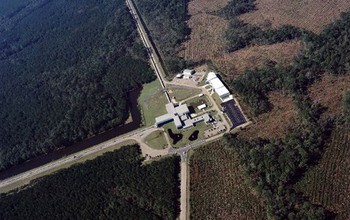搜索结果: 1-15 共查到“天体物理学其他学科 O Stars”相关记录26条 . 查询时间(0.234 秒)

LIGO and Virgo make first detection of gravitational waves produced by colliding neutron stars(图)
LIGO Virgo first detection gravitational waves produced colliding neutron stars
2017/10/26
For the first time, scientists have directly detected gravitational waves -- ripples in space-time -- in addition to light from the spectacular collision of two neutron stars. This marks the first tim...

First Observations Of Merging Neutron Stars Mark A New Era In Astronomy(图)
First Observations Merging Neutron Stars Mark New Era Astronomy
2017/10/26
Two months ago, the Advanced Laser Interferometer Gravitational-Wave Observatory (LIGO) notified astronomers around the world of the possible detection of gravitational waves from the merger of two ne...
RIT study suggests dying stars give newborn black holes a swift kick
RIT study dying stars newborn black holes swift kick
2017/7/21
New information gleaned from gravitational wave observations is helping scientists understand what happens when massive stars die and transform into black holes.
Rochester Institute of Technology res...
Tsunami of Stars and Gas Produces Dazzling Eye-shaped Feature in Galaxy
Tsunami Stars Gas Dazzling Eye-shaped Galaxy
2016/11/29
Astronomers using the Atacama Large Millimeter/submillimeter Array (ALMA) have discovered a tsunami of stars and gas that is crashing midway through the disk of a spiral galaxy known as IC 2163. This ...
Astronomers Peer Inside Stars,Finding Giant Magnets
Astronomers Peer Inside Stars Giant Magnets
2015/11/12
Using a technique called asteroseismology, the scientists were able to calculate the magnetic field strengths in the fusion-powered hearts of dozens of red giants, stars that are evolved versions of o...
Chemical evolution of the Galactic bulge as traced by microlensed dwarf and subgiant stars. IV. Two bulge populations
Gravitational lensing: micro—Galaxy: bulge —Galaxy: formation —Galaxy: evolution —Stars: abundances
2011/10/20
Based on high-resolution (R~42000 to 48000) and high signal-to-noise (S/N~50 to 150) spectra obtained with UVES/VLT, we present detailed elemental abundances (O, Na, Mg, Al, Si, Ca, Ti, Cr, Fe, Ni, Zn...
Three-dimensional (3D) hydrodynamic simulations of shell oxygen burning (Meakin and Arnett 2007) exhibit bursty, recurrent fluctuations in turbulent kinetic energy. These are shown to be due to a glob...
Cosmic Chemical Evolution with an Early Population of Intermediate Mass Stars
Cosmic Chemical Evolution Intermediate Mass Stars
2011/1/11
We explore the consequences of an early population of intermediate mass stars in the 2 - 8 M\odot range on cosmic chemical evolution. We discuss the implications of this population as it pertains to s...
Pasta Structures of Quark-Hadron Phase Transition in Proto-Neutron Stars
Pasta Structures Quark-Hadron Phase Transition
2011/1/11
We study the quark-hadron mixed phase in proto-neutron stars with the finite-size effects. In the calculations of pasta structures appeared in the mixed phase, the Gibbs conditions require the pressur...
We present results of a survey of post-asymptotic giant branch stars (post-AGBs) at high galactic latitude. To date, few post-AGB stars are known throughout the Galaxy and the number of known members ...
Effects of rotation and magnetic fields on the lithium abundance and asteroseismic properties of exoplanet-host stars
magnetic fields the lithium abundance asteroseismic properties
2011/1/11
Aims: The effects of rotation and magnetic fields on the surface abundances of solar-type stars are studied in order to investigate whether the reported difference in lithium content of exoplanet-host...
There is much debate on how high-mass star formation varies with environment, and whether the sparsest star-forming environments are capable of forming massive stars. To address this issue, we have ob...
The chemical composition of the Orion star-forming region: II. Stars, gas, and dust: the abundance discrepancy conundrum
the Orion star-forming region II. Stars
2011/1/13
We re-examine the recombination/collisional emission line (RL/CEL) nebular abundance discrepancy problem in the light of recent high-quality abundance determinations in young stars in the Orion star-f...
Population I Wolf-Rayet Runaway Stars: the Case of WR124 and its Expanding Nebula M1-67
gamma-ray burst general stars distances stars individual individual
2010/11/10
In 1997 and 2008 we used the WFPC2 camera on board of the Hubble Space Telescope to obtain two sets of narrow-band H
images of the runaway Wolf-Rayet (WR) star WR 124 surrounded by its nebula M1–67. ...
Lyman `bump' galaxies - II. A possible signature of massive extremely metal-poor or metal-free stars in z=3.1 Ly-alpha emitters
Cosmology and Extragalactic Astrophysics (astro-ph.CO)
2010/12/29
Deep NB359 imaging with Subaru by Iwata et al. have detected surprisingly strong Lyman continuum (LyC; ~900A in the rest-frame) from some LAEs at z=3.1. However, the redshifts might be misidentified d...

